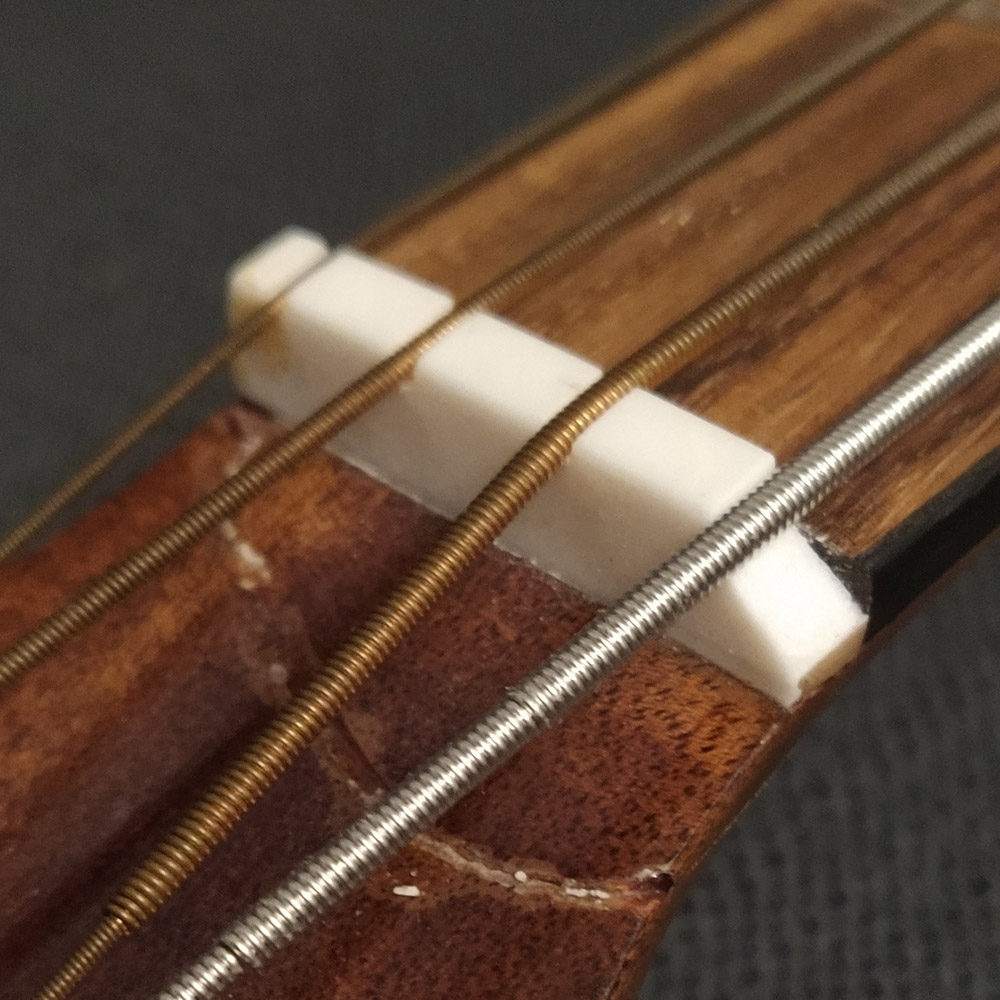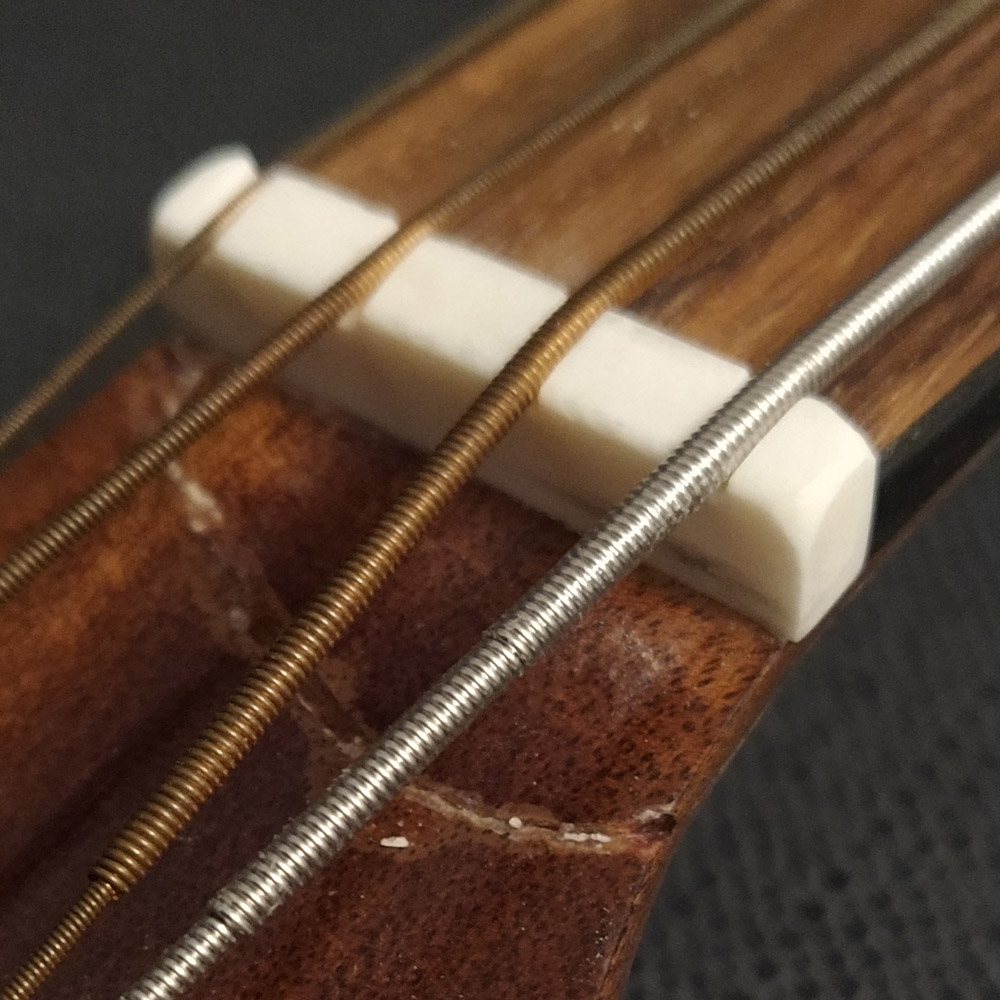The school where I repair guitars has an acoustic bass, and somehow the nut was cracked. I don't know how you crack a nut, but the various guitar damage I have repaired over the years nothing surprises me anymore. In fact a few years ago the headstock on this acoustic bass was clean broken off. I wasn't game to fix that so it was professionally reattached, you can still see a bit of the scar in the photos. The repair on the back of the neck - where it counts - is smooth as, so good job whoever you are.
Since I had recently made a nut for my custom electric (I still need to remake that nut) I was in the nut making zone. I had already stocked up on bone blanks for nuts and saddles (they are cheap from Aliexpress), and I had one that was the right thickness it just needed to be cut down in width and the height made to match the fretboard curve. Once I had chiselled out the old nut, I cleaned the glue from the nut slot with a small file. I have an inexpensive set of jewellers files, it comes in handy.
I use a cheap hobby vice to hold the nut while I file it, and I have a small piece of super flat marble stone for putting sheets of sandpaper on to get those perfectly flat edges. A good trick I saw on the internet for when you have something thin and you are trying to get the thin edge to 90° and flat - put another object with a perfect 90° edge on and run your thin edge piece back and forth on the sandpaper along the side of it.
Because bass strings are so fat, even the thickest guitar nut slot file I have is too thin...the jewellers files came in hand for that again. I based my nut spacing on the old nut which was already pretty good. I set the depth with the tap test - if you fret the 3rd and then tap on the string at the first fret there should be the tiniest gap, just enough to get a 'plink' as you tap. This makes a lot of sense to me - the string height at the nut should basically be the same as if there was another fret behind. If the string height is too high then you are bending the string too much when you fret the first, and you will hear that in the intonation, the open string will be in tune but the first fret will be sharp. I find I get this anyway, I fret too hard, so I'm pushing the string too far into the fret which sharpens it. It's nice however when you have the string height at the nut as low as possible to begin with.
If you file the slot too low, then the string is going to buzz on the first fret. That's not good. This what naturally happened to my main classical, after years of tuning - pulling the strings through the slots - they are actually worn down too far, and the open string buzzes.
Even with the nut slots as low as I could take them, this bass guitar is still pretty awful to play, the action is so high! I filed down the saddle which improved it but not enough. I adjusted the truss rod - to the point the top string was starting to buzz a little and then backed it off a turn or two. The truss rod is only really for adjusting the neck relief not action, even though it does affect action. What the real problem with that guitar is - the neck angle.
To be honest, almost every guitar I come across that is more than say 20 years old has a slightly wrong neck angle. This makes sense - wood is not a dead piece of spring steel - over time , under constant force, wood is going to give a little. The physics of the situation is that most of the force is in the plane of the neck - so not pulling up - but there is enough force there for something to give over time. The give seems to be on the soundboard, which also makes sense. You end up having a very slight caving in deflection of the sound board between the neck and the sound hole. Guitar makers don't make a soundboard so rigid it will resist deflecting in - that would spoil the tone.
So, I would say most 20+ year old guitars need a neck reset. Basically detach the neck, cut some meat/new angle out of the heel, reattach. I've seen formulas on the internet for calculating the amount to remove, usually ends up being a millimetre or two. Once you glue it back on - the soundboard caving in/etc is still there - but now the neck is compensated for it. And you are back to blissful action again!
Generally the lower the action - given that there are no buzzes anywhere - the more playable the guitar is. You don't have to take you fretting fingers off and on so far as you refret. It's just a nicer experience. It feels like the guitar is working with you instead of against you. Even my main classical's action is starting to get a teensy bit high. It is a 2002 model, so that fits my 20+ theory. For now I'm going to stick with lower tension strings for a while.
But my oldest classical from the late 70's is quite far gone. I'd like to adjust it. I've seen an interesting hack where you cut through the heel with a thin saw, and then reglue and clamp the cut. You won't get the same perfect mating surface when you bend the heel in, so it will need to be the right type of glue to hold and fill, but the neck angle will have been readjusted. Maybe I'll buy an old cheap classical and practise on that first :-)

